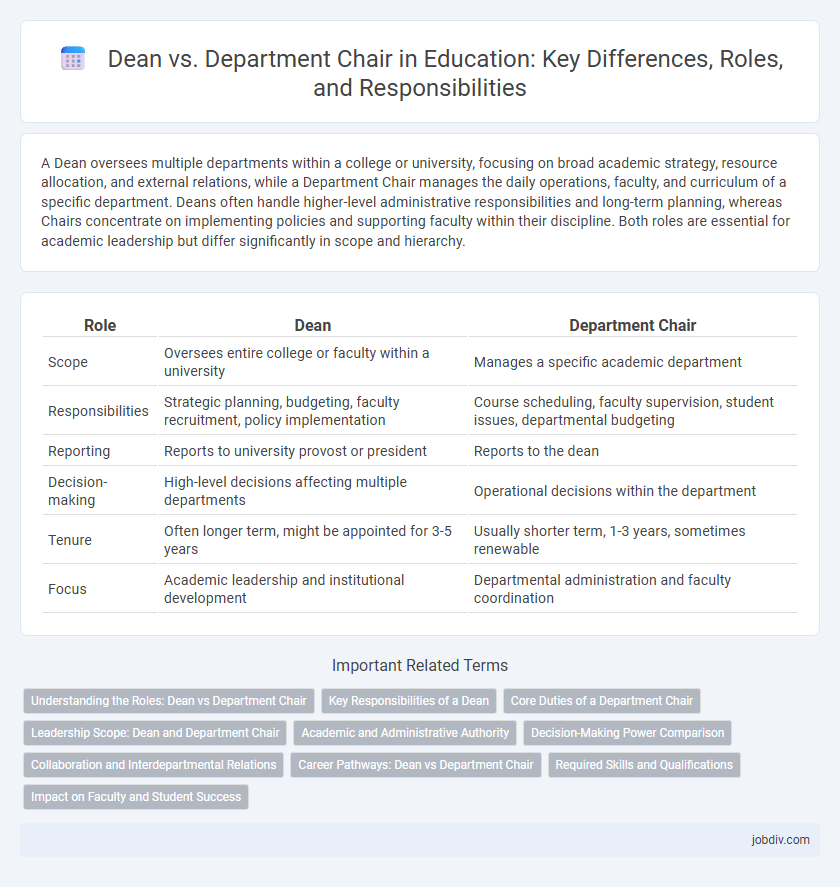A Dean oversees multiple departments within a college or university, focusing on broad academic strategy, resource allocation, and external relations, while a Department Chair manages the daily operations, faculty, and curriculum of a specific department. Deans often handle higher-level administrative responsibilities and long-term planning, whereas Chairs concentrate on implementing policies and supporting faculty within their discipline. Both roles are essential for academic leadership but differ significantly in scope and hierarchy.
Table of Comparison
| Role | Dean | Department Chair |
|---|---|---|
| Scope | Oversees entire college or faculty within a university | Manages a specific academic department |
| Responsibilities | Strategic planning, budgeting, faculty recruitment, policy implementation | Course scheduling, faculty supervision, student issues, departmental budgeting |
| Reporting | Reports to university provost or president | Reports to the dean |
| Decision-making | High-level decisions affecting multiple departments | Operational decisions within the department |
| Tenure | Often longer term, might be appointed for 3-5 years | Usually shorter term, 1-3 years, sometimes renewable |
| Focus | Academic leadership and institutional development | Departmental administration and faculty coordination |
Understanding the Roles: Dean vs Department Chair
A Dean oversees multiple academic departments within a college or school, setting strategic priorities, managing budgets, and representing the unit in university governance. A Department Chair leads a specific academic department, handling faculty coordination, curriculum development, and daily administrative tasks. Understanding the roles clarifies their distinct responsibilities and collaboration in advancing educational goals.
Key Responsibilities of a Dean
A Dean oversees multiple academic departments, setting strategic goals, managing budgets, and ensuring institutional compliance with accreditation standards. They lead faculty recruitment, professional development, and promote research initiatives to enhance academic excellence. Deans also serve as the primary liaison between university administration and departments, driving policy implementation and fostering community engagement.
Core Duties of a Department Chair
The Department Chair oversees faculty performance, curriculum development, and resource management within their specific academic department. They act as the primary liaison between faculty members and higher administration, ensuring departmental goals align with university policies. Core duties also include scheduling courses, facilitating faculty meetings, and managing departmental budgets.
Leadership Scope: Dean and Department Chair
The Dean oversees multiple academic departments, managing broader strategic initiatives and institutional goals at the college or faculty level. The Department Chair leads a single academic department, focusing on curriculum development, faculty coordination, and departmental operations. Leadership scope for Deans encompasses cross-departmental collaboration and resource allocation, while Department Chairs handle day-to-day academic and administrative tasks within their specific department.
Academic and Administrative Authority
The Dean holds broader academic and administrative authority, overseeing multiple departments and setting strategic priorities for a college or school within a university. The Department Chair manages a specific academic department, focusing on curriculum development, faculty coordination, and day-to-day administrative tasks. Deans typically have higher decision-making power in budget allocation and institutional policies compared to department chairs.
Decision-Making Power Comparison
Deans hold broader decision-making authority encompassing budget allocation, strategic planning, and faculty appointments across multiple departments within a college or school, while department chairs primarily focus on decisions related to curriculum development, faculty evaluation, and daily operations within their specific department. The dean's role involves oversight of interdepartmental coordination and long-term academic goals, giving them a higher level of influence over institutional priorities. Department chairs execute policies and manage departmental resources but often require dean approval for major initiatives and budgetary changes.
Collaboration and Interdepartmental Relations
Deans oversee multiple academic departments, fostering strategic collaboration across faculties to enhance interdisciplinary research and curriculum development. Department Chairs manage specific departments, coordinating faculty efforts and facilitating communication within and between departments to optimize academic outcomes. Effective collaboration between Deans and Department Chairs strengthens interdepartmental relations, driving innovation and cohesive educational programs.
Career Pathways: Dean vs Department Chair
Career pathways for a Dean typically involve extensive experience in academic leadership, often progressing from faculty roles to department chair positions before overseeing multiple departments or entire colleges. Department Chairs usually advance through proven expertise in their discipline and leadership within their department, focusing on curriculum management and faculty coordination. The Dean's role demands broader strategic planning and external relations, while Department Chairs emphasize operational management and direct academic support.
Required Skills and Qualifications
A Dean typically requires advanced leadership skills, strategic planning expertise, and often holds a terminal degree such as a PhD or EdD, along with extensive administrative experience in higher education. A Department Chair usually needs strong organizational abilities, subject matter expertise in their academic discipline, and a proven track record in teaching and research, often holding at least a master's or doctoral degree. Both roles demand excellent communication skills and the ability to manage faculty and resources effectively within their institutions.
Impact on Faculty and Student Success
Deans oversee multiple departments, driving strategic initiatives that foster interdisciplinary collaboration and allocate resources to enhance faculty research opportunities and student academic programs. Department Chairs directly manage faculty workload, curriculum development, and student advising within their department, ensuring tailored support and timely interventions for student success. The combined leadership of Deans and Department Chairs creates a robust environment promoting faculty development and improving graduation rates.
Dean vs Department Chair Infographic

 jobdiv.com
jobdiv.com